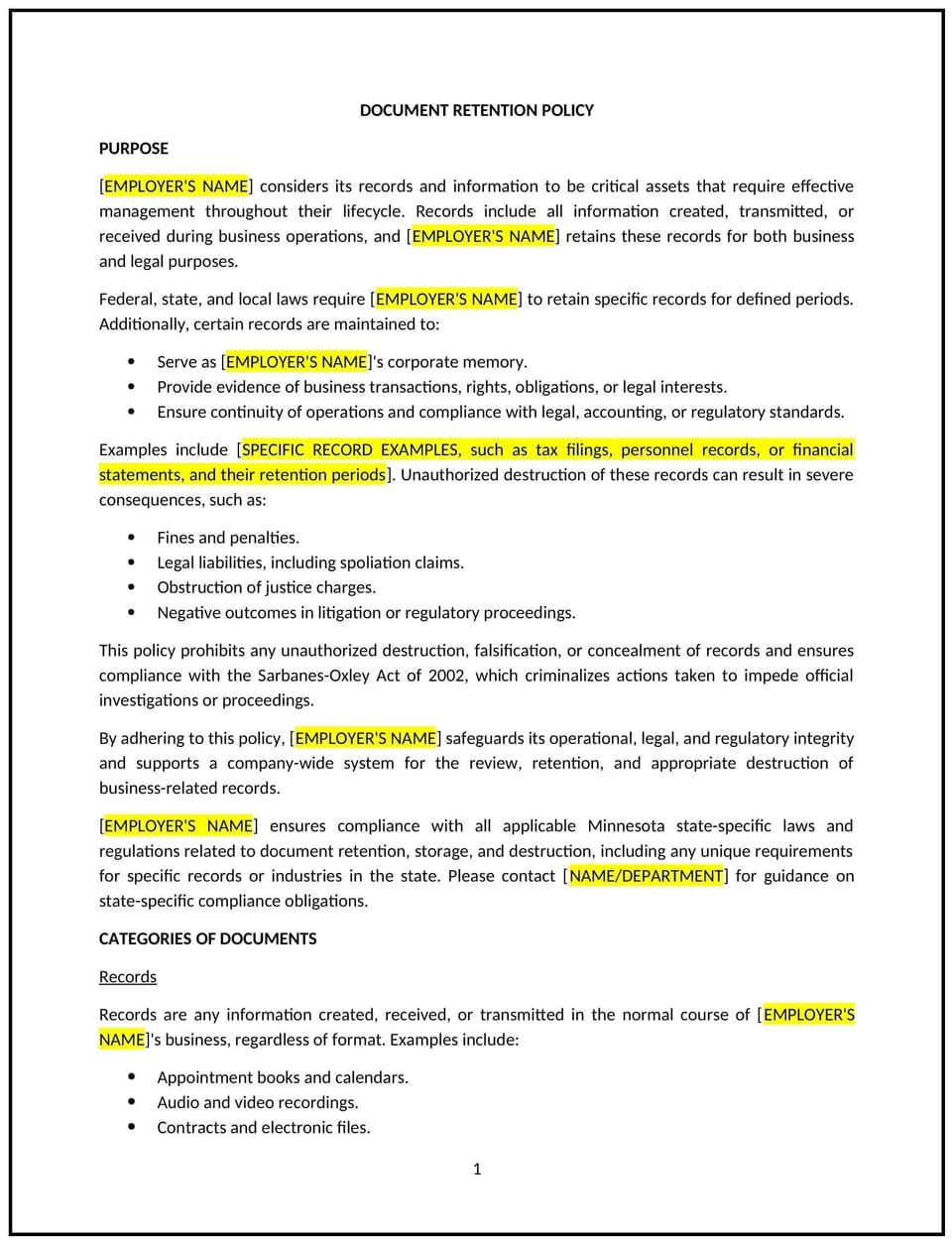Document retention policy (Minnesota): Free template

Document retention policy (Minnesota)
This document retention policy is designed to help Minnesota businesses establish guidelines for retaining, managing, and disposing of business documents in a consistent and legally compliant manner. It outlines the types of documents that must be retained, the retention periods, and the procedures for securely disposing of documents once they are no longer needed.
By implementing this policy, businesses can maintain proper records, reduce the risk of legal issues, and ensure that documents are accessible when needed for business operations or regulatory purposes.
How to use this document retention policy (Minnesota)
- Define document types: Specify the types of documents that are covered by the policy, including financial records, employee files, contracts, emails, and legal documents.
- Establish retention periods: Set clear guidelines for how long different types of documents should be retained, based on business needs, legal requirements, and Minnesota-specific regulations.
- Set procedures for secure storage: Detail how documents should be stored, whether in physical files or digital formats, ensuring that sensitive information is protected from unauthorized access.
- Outline disposal methods: Specify how documents should be safely destroyed or deleted when they are no longer needed, including shredding physical documents and securely deleting electronic files.
- Assign responsibilities: Identify the individuals or departments responsible for managing document retention and disposal, ensuring accountability and oversight.
- Include audit procedures: Set up regular audits to ensure that the policy is being followed and that outdated documents are properly disposed of according to the policy.
Benefits of using a document retention policy (Minnesota)
Implementing this policy provides several advantages for Minnesota businesses:
- Reduces legal risk: Proper document retention reduces the risk of legal penalties for failure to retain records in accordance with state and federal regulations.
- Enhances efficiency: By eliminating unnecessary documents and records, businesses can streamline operations and improve document management practices.
- Protects sensitive information: Securely storing and disposing of confidential documents minimizes the risk of data breaches and unauthorized access.
- Promotes organizational consistency: A standardized approach to document retention ensures that employees follow the same procedures, reducing confusion and inconsistency.
- Reflects Minnesota-specific considerations: Tailors the policy to comply with Minnesota state laws regarding record retention, privacy, and data protection.
Tips for using this document retention policy (Minnesota)
- Communicate clearly: Ensure that all employees understand their roles in document retention and disposal and are familiar with the types of documents that need to be retained.
- Provide training: Offer periodic training on the document retention policy to ensure employees know how to handle sensitive documents and are aware of the importance of compliance.
- Implement technology: Use document management software or systems to help organize, store, and track the retention of electronic files, making it easier to manage and search for records.
- Monitor compliance: Conduct regular audits to verify that documents are being retained and disposed of in accordance with the policy, and make adjustments as needed.
- Review regularly: Periodically review the policy to ensure it aligns with changes in business operations, state regulations, or industry standards.
Q: What types of documents are covered under this policy?
A: Businesses should specify the types of documents that must be retained, such as financial records, employee files, contracts, tax documents, correspondence, and other critical business records.
Q: How long should documents be retained?
A: The retention period will vary depending on the document type and legal or regulatory requirements. Businesses should follow the retention guidelines established for each document category, which could range from a few years to indefinitely.
Q: What should businesses do when documents are no longer needed?
A: Once documents reach the end of their retention period, businesses should securely dispose of them. Physical documents should be shredded, and electronic files should be permanently deleted using secure methods.
Q: Who is responsible for managing document retention?
A: The business should assign responsibility to specific individuals or departments, such as HR, legal, or finance, to oversee document retention, storage, and disposal processes.
Q: What happens if a document is retained beyond the specified period?
A: Businesses should periodically audit their records to ensure compliance with the retention policy. Retaining documents longer than necessary can lead to unnecessary storage costs and potential privacy risks.
Q: How can businesses ensure the secure storage of sensitive documents?
A: Businesses should use secure storage methods, such as password-protected digital files, encrypted storage solutions, and locked file cabinets for physical records, to protect sensitive documents.
Q: How often should this policy be reviewed?
A: The policy should be reviewed annually or whenever there are changes in business operations, applicable laws, or Minnesota-specific regulations regarding document retention.
This article contains general legal information and does not contain legal advice. Cobrief is not a law firm or a substitute for an attorney or law firm. The law is complex and changes often. For legal advice, please ask a lawyer.


